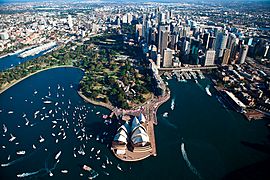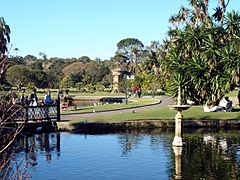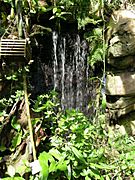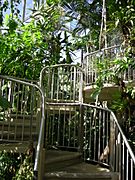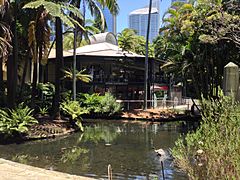Royal Botanic Garden, Sydney facts for kids
Quick facts for kids Royal Botanic Garden, Sydney |
|
|---|---|

Entrance to the Royal Botanic Garden from Art Gallery Road
|
|
| Lua error in Module:Location_map at line 420: attempt to index field 'wikibase' (a nil value). | |
| Type | Botanical garden |
| Location | The Domain, Sydney, New South Wales, Australia () |
| Area | 30 hectares (74 acres) |
| Created | 1816 |
| Founder | Governor Lachlan Macquarie |
| Operated by | Royal Botanic Gardens and Domain Trust trading as the Botanic Gardens and Centennial Parklands |
| Visitors | 3,544,344 (in 2016) |
| Open |
|
| Status | Open all year |
| Public transit access | |
| Official name | Royal Botanic Gardens and Domain; Tarpeian Way; Botanical Gardens |
| Type | State heritage (landscape) |
| Designated | 2 April 1999 |
| Reference no. | 1070 |
| Type | Garden Botanic |
| Category | Parks, Gardens and Trees |
| Builders | Charles Fraser; Allan Cunningham; Richard Cunningham; Charles Moore; Joseph Maiden; Carrick Chambers |
The Royal Botanic Garden, Sydney is a famous garden in Sydney, Australia. It covers about 30 hectares (74 acres) and is a great place for events and public fun. You can find it right next to Farm Cove, near the city center.
This garden opened in 1816. It is the oldest scientific place in Australia. It is also one of the most important historic plant gardens in the world. Many people helped design and build it over the years. These include Charles Moore and Joseph Maiden. The garden is owned by the government of New South Wales. It is managed by the Royal Botanic Gardens and Domain Trust. The garden and the nearby Domain were added to the New South Wales State Heritage Register in 1999.
The Garden and The Domain are open every day, and it's free to enter. Its amazing location on Sydney Harbour, near the Sydney Opera House, makes it very popular. It is one of the most visited places in Sydney.
Contents
Where is the Garden Located?
The Royal Botanic Garden is just southeast of the Sydney Opera House. It curves around Farm Cove. The garden covers 30 hectares. It is surrounded by the Cahill Expressway to the south and west. Art Gallery Road is to the east, and Sydney Harbour is to the north.
How the Garden Started and Grew
The first farm by European settlers in Australia was at Farm Cove in 1788. Governor Phillip started it. Even though that farm didn't work out, the land has been used for growing plants ever since. People found ways to make the soil better.
Governor Macquarie founded the Botanic Gardens in 1816. It was part of the Governor's Domain. Australia's long history of studying plants began in 1817. That's when the first Colonial Botanist, Charles Fraser, was appointed. This makes the Botanic Gardens the oldest scientific place in Australia. It has always been important for bringing plants from other parts of the world.
After several botanists and leaders, John Carne Bidwill became the first Director in 1847.
Charles Moore's Impact
The next Director was Charles Moore (1820-1905). He was from Scotland and trained in Dublin. Moore was Director for 48 years, from 1848 to 1896. He did a lot to make the Botanic Gardens what they are today. He worked hard to fix problems like poor soil and not enough water.
The Palm Grove in the middle of the Garden shows his skill. He also helped create new land behind the Farm Cove seawall. This made the Garden much bigger. Moore also helped write a book about the plants of New South Wales. This showed the Garden was a key place for plant science.
The Garden's Old Zoo
The Botanic Garden used to have a zoo! It was Sydney's first zoo. It operated in the Gardens from 1862 to 1883. Most of the animals then moved to Moore Park. During these years, many native trees in the Domain were removed. New parkland was planted. The huge Moreton Bay Figs you see today were part of this planting.
The Grand Garden Palace
In 1879, a large area of the Domain was used for the Garden Exhibition Palace. This building was amazing, with towers and a huge dome. The International Exhibition held there brought over a million visitors. Sadly, the building burned down in 1882. The land, now called the Palace Garden, was added to the Botanic Gardens.
Joseph Henry Maiden's Contributions
Joseph Henry Maiden took over after Moore. He was Director for 28 years. He added a lot to the Garden's growing landscape. He built a new herbarium building in 1901. This building is now part of the Anderson Building. He also made big improvements to the Domain.
However, the Garden lost staff during World War I. In the 1930s, during the Great Depression, the Director's job was even removed. Both the plant collections and the Herbarium struggled.
After 1945
After 1945, Robert Anderson worked to bring the two parts of the Garden back together. In 1959, the Garden was given the title 'Royal'. The Herbarium and Royal Botanic Garden were joined again. They were called the Royal Botanic Garden. Knowles Mair (1965–70) finished this work. The Royal Botanic Garden started to become famous again.
Dr. John Beard (1970–72) and Dr. Lawrence Johnson (1972–85) helped the organization grow more. The Robert Brown Building opened in 1982 for the Herbarium. Many new activities started. These included groups like the Friends of the Royal Botanic Garden. Educational programs and scientific journals also began.
New gardens opened to the public after Professor Carrick Chambers became Director in 1986. These included the Mount Tomah Botanic Garden (1987) and the Mount Annan Botanic Garden (1988). The Tropical Centre glasshouses also got bigger in 1990. The Royal Botanic Gardens celebrated its 175th birthday in 1991. During Professor Chambers' time, new areas like the Rose Garden (1988) and the Fernery (1993) opened. The Herb Garden (1994) and the Oriental Garden (1997) also opened. The Rare and Threatened Species Garden (1998) was started.
New Management (2014)
In 2014, it was announced that the Royal Botanic Garden Sydney would be managed by a new group. This group is called the Botanic Gardens & Centennial Parklands.
Who Manages the Gardens?
The Royal Botanic Gardens and Domain Trust is in charge of the gardens. This trust was created in 1980 by a law in New South Wales. The trust also looks after the nearby Domain. It manages the Australian Botanic Garden Mount Annan and the Blue Mountains Botanic Garden Mount Tomah. The trust sets the rules, but the staff of 'Botanic Gardens & Centennial Parklands' run the Garden every day.
Garden Layout and Cool Features
The Garden covers 30 hectares. It is shaped like a big natural amphitheater. It slopes down towards Farm Cove, like a stage. The Garden has four main areas: the Lower Gardens, the Middle Gardens, the Palace Gardens, and the Bennelong precinct. Inside these areas are many smaller gardens and open grassy spots. In the middle of the Garden is the Palm Grove Centre. Here you can find a restaurant, a cafe, a visitor center, and a bookshop.
A very special part of the Garden is the old sandstone seawall. It was built by hand. It curves around Farm Cove, from Mrs Macquarie's Point to the Opera House. This wall separates the garden from the harbor. It's a great spot for visitors, joggers, and photographers.
Lower Gardens
The Lower Gardens have the Band Lawn and the main Ponds. You can also see the HSBC Oriental Garden here. Other features include the Yurong, Victoria Lodge, Henry Lawson Gates, and the Maiden Pavilion.
Middle Gardens
In the Middle Gardens, you'll find the Palm House. There's also the famous Wollemi Pine. Other areas include the Succulent Garden and the Rare and Threatened Plant Garden. The Herbarium & Plant Sciences Building is here. You can also see the Lion Gate Lodge, the Begonia Garden, and the Macquarie Wall and Spring Walk.
Palace Gardens
The Palace Gardens feature the Tropical Centre. This area is currently closed for updates. You can walk along the Rainforest Walk. There's also the Pioner Garden and the Morshead Fountain Gate. Don't miss the Palace Garden Gate, the Rose Garden & Pavilion, and the Turf Plots. The Old Mill Garden and the Herb Garden are also here. The Sydney Conservatorium of Music is nestled in this area.
Bennelong Precinct
The Bennelong Precinct has Government House. It also includes the Parade Ground and the Australian Native Rockery. You can relax on Bennelong Lawn. The Queen Elizabeth II Gate is also in this area.
Palm Grove Centre
The Palm Grove Centre has the beautiful Palm Grove. It also features a Cafe, a Garden Shop, and the Botanic Gardens Restaurant.
Daniel Solander Library
The library at the Royal Botanic Gardens started in 1852. It is named after Daniel Solander (1733 - 1782). He was a student of Linnaeus, a famous scientist. Solander worked at the British Museum. In 1768, he joined Joseph Banks on James Cook's first trip to the Pacific. When they returned, he became Banks' botanist and librarian.
This library is the oldest plant research library in Australia. It has many books about gardening, plants, and how to classify them. It is inside the National Herbarium of New South Wales. The Herbarium has over 1.2 million plant samples. Some of these were collected by Banks and Solander on Cook's voyage.
Flying Foxes in the Garden
For many years, the Royal Botanic Gardens was home to a large group of native Grey-headed Flying Foxes. These are a big type of fruit bat. Sometimes, there were over 20,000 of them! They caused a lot of damage to the trees where they rested. Especially around the Palm Grove Centre, many old trees were killed or badly hurt.
In May 2010, the trust announced a plan to make the bats leave. They used very loud noises to scare them away. This plan was delayed for several years by a court case. An animal welfare group challenged it. But in June 2012, the trust finally got approval to go ahead. By June 2013, all the bats had left the Garden. The damaged trees started to get better.
Interestingly, many of these bats moved to a natural bushland area. This area was on the north coast of New South Wales. It was planned to be destroyed for a highway upgrade. The destruction of this forest became a big public issue in 2014. Building the road was delayed while the government checked the environmental impact.
Images for kids
-
The International Exhibition of 1879 at the Garden Palace
See also
 In Spanish: Real jardín botánico de Sídney para niños
In Spanish: Real jardín botánico de Sídney para niños






